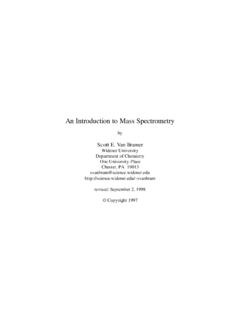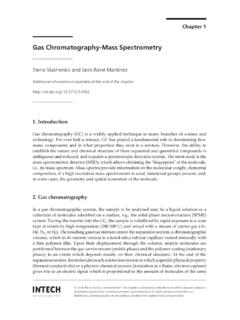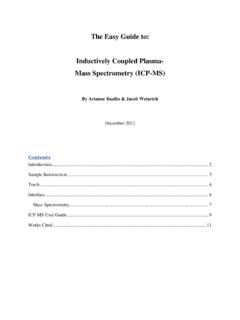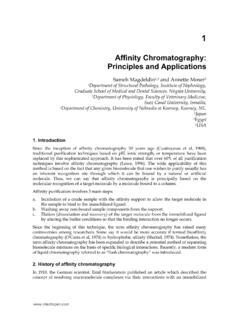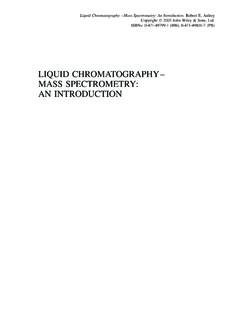Transcription of EPA Method 525.2: Determination of Organic Compounds in ...
1 Method Determination OF Organic Compounds IN DRINKING WATER BY LIQUID-SOLID EXTRACTION AND CAPILLARY COLUMN GAS chromatography / mass spectrometry Revision Eichelberger, Behymer, Budde - Method 525, Revision , , (1988) Eichelberger, Behymer, and Budde - Method Revision (July 1991) Eichelberger, Munch, and Shoemaker Method Revision (February, 1994) Munch - Method , Revision (1995) NATIONAL EXPOSURE RESEARCH LABORATORY OFFICE OF RESEARCH AND DEVELOPMENT ENVIRONMENTAL PROTECTION AGENCY CINCINNATI, OHIO 45268 Method Determination OF Organic Compounds IN DRINKING WATER BY LIQUID-SOLID EXTRACTION AND CAPILLARY COLUMN GAS chromatography / mass spectrometry SCOPE AND APPLICATION This is a general purpose Method that provides procedures for Determination of Organic Compounds in finished drinking water, source water, or drinking water in any treatment stage.
2 The Method is applicable to a wide range of Organic Compounds that are efficiently partitioned from the water sample onto a C18 Organic phase chemically bonded to a solid matrix in a disk or cartridge, and sufficiently volatile and thermally stable for gas chromatog-raphy. Single-laboratory accuracy and precision data have been determined with two instrument systems using both disks and cartridges for most of the following Compounds : Chemical Abstract Services Analyte MW1 Registry Number Acenaphthylene 152 208-96-8 Alachlor 269 15972-60-8 Aldrin 362 309-00-2 Ametryn 227 834-12-8 Anthracene 178 120-12-7 Atraton 211 1610-17-9 Atrazine 215 1912-24-9 Benz[a]anthracene 228 56-55-3 Benzo[b]fluoranthene 252 205-82-3 Benzo[k]fluoranthene 252 207-08-9 Benzo[a]pyrene 252 50-32-8 Benzo[g,h,i]
3 Perylene 276 191-24-2 Bromacil 260 314-40-9 Butachlor 311 23184-66-9 Butylate 317 2008-41-5 Butylbenzylphthalate 312 85-68-7 Carboxin2 235 5234-68-4 Chlordane components alpha-Chlordane 406 5103-71-9 gamma-Chlordane 406 5103-74-2 trans-Nonachlor 440 39765-80-5 Chlorneb 206 2675-77-6 Chlorobenzilate 324 510-15-6 Chlorpropham 213 101-21-3 Chlorothalonil 264 1897-45-6 Chemical Abstract Services Analyte MW1 Registry Number Chlorpyrifos 349 2921-88-2 2-Chlorobiphenyl 188 2051-60-7 Chrysene 228 218-01-9 Cyanazine 240 21725-46-2 Cycloate 215 1134-23-2 Dacthal (DCPA) 330 1861-32-1 4,4'-DDD 318 72-54-8 4,4'-DDE 316 72-55-9 4,4'-DDT 352 50-29-3 Diazinon2 304 333-41-5 Dibenz[a,h]anthracene 278 53-70-3 Di-n-Butylphthalate 278 84-74-2 2,3-Dichlorobiphenyl 222 16605-91-7 Dichlorvos 220 62-73-7 Dieldrin 378 60-57-1 Diethylphthalate 222 84-66-2 Di(2-ethylhexyl)adipate 370 103-23-1 Di(2-ethylhexyl)
4 Phthalate 390 117-81-7 Dimethylphthalate 194 131-11-3 2,4-Dinitrotoluene 182 121-14-2 2,6-Dinitrotoluene 182 606-20-2 Diphenamid 239 957-51-7 Disulfoton2 274 298-04-4 Disulfoton Sulfoxide2 290 2497-07-6 Disulfoton Sulfone 306 2497-06-5 Endosulfan I 404 959-98-8 Endosulfan II 404 33213-65-9 Endosulfan Sulfate 420 1031-07-8 Endrin 378 72-20-8 Endrin Aldehyde 378 7421-93-4 EPTC 189 759-94-4 Ethoprop 242 13194-48-4 Etridiazole 246 2593-15-9 Fenamiphos2 303 22224-92-6 Fenarimol 330 60168-88-9 Fluorene 166 86-73-7 Fluridone 328 59756-60-4 Heptachlor 370 76-44-8 Heptachlor Epoxide 386 1024-57-3 2,2', 3,3', 4,4', 6-Heptachloro biphenyl 392 52663-71-5 Hexachlorobenzene 282 118-74-1 2,2', 4,4', 5,6'-Hexachloro biphenyl 358 60145-22-4 Chemical Abstract Services Analyte MW1 Registry Number Hexachlorocyclohexane, alpha 288 319-84-6 Hexachlorocyclohexane, beta 288 319-85-7 Hexachlorocyclohexane, delta 288 319-86-8 Hexachlorocyclopentadiene 270 77-47-4 Hexazinone 252 51235-04-2 Indeno[1,2,3,c,d]
5 Pyrene 276 193-39-5 Isophorone 138 78-59-1 Lindane 288 58-89-9 Merphos2 298 150-50-5 Methoxychlor 344 72-43-5 Methyl Paraoxon 247 950-35-6 Metolachlor 283 51218-45-2 Metribuzin 214 21087-64-9 Mevinphos 224 7786-34-7 MGK 264 275 113-48-4 Molinate 187 2212-67-1 Napropamide 271 15299-99-7 Norflurazon 303 27314-13-2 2,2', 3,3', 4,5', 6,6'-Octachloro biphenyl 426 40186-71-8 Pebulate 203 1114-71-2 2,2', 3', 4,6'-Pentachlorobiphenyl 324 60233-25-2 Pentachlorophenol 264 87-86-5 Phenanthrene 178 85-01-8 cis-Permethrin 390 54774-45-7 trans-Permethrin 390 51877-74-8 Prometon 225 1610-18-0 Prometryn 241 7287-19-6 Pronamide 255 23950-58-5 Propachlor 211 1918-16-7 Propazine 229 139-40-2 Pyrene 202 129-00-0 Simazine 201 122-34-9 Simetryn 213 1014-70-6 Stirofos 364 22248-79-9 Tebuthiuron 228 34014-18-1 Terbacil 216 5902-51-2 Terbufos2 288 13071-79-9 Terbutryn 241 886-50-0 2,2', 4,4'-Tetrachlorobiphenyl 290 2437-79-8 Toxaphene 8001-35-2 Triademefon 293 43121-43-3 2,4.
6 5-Trichlorobiphenyl 256 15862-07-4 Tricyclazole 189 41814-78-2 Chemical Abstract Services Analyte MW1 Registry Number Trifluralin 335 1582-09-8 Vernolate 203 1929-77-7 Aroclor 1016 12674-11-2 Aroclor 1221 11104-28-2 Aroclor 1232 11141-16-5 Aroclor 1242 53469-21-9 Aroclor 1248 12672-29-6 Aroclor 1254 11097-69-1 Aroclor 1260 11096-82-5 1 Monoisotopic molecular weight calculated from the atomic masses of the isotopes with the smallest masses. 2 Only qualitative identification of these analytes is possible because of their instability in aqueous matrices. Merphos, carboxin, disulfoton, and disulfoton sulfoxide showed instability within 1 h of fortification.
7 Diazinon, fenamiphos, and terbufos showed significant losses within seven days under the sample storage conditions specified in this Method . Attempting to determine all of the above analytes in all samples is not practical and not necessary in most cases. If all the analytes must be determined, multiple calibration mixtures will be required. Method detection limit (MDL) is defined as the statistically calculated minimum amount that can be measured with 99% confidence that the reported 1value is greater than zero . The MDL is compound dependent and is particularly dependent on extraction efficiency and sample matrix. MDLs for all Method analytes are listed in Tables 3 through 6.
8 The concentration calibration range demonstrated in this Method is g/L for most analytes. SUMMARY OF Method Organic compound analytes, internal standards, and surrogates are extracted from a water sample by passing 1 L of sample water through a cartridge or disk containing a solid matrix with a chemically bonded C18 Organic phase (liquid-solid extraction, LSE). The Organic Compounds are eluted from the LSE cartridge or disk with small quantities of ethyl acetate followed by methylene chloride, and this extract is concentrated further by evaporation of some of the solvent. The sample components are separated, identified, and measured by injecting an aliquot of the concentrated extract into a high resolution fused silica capillary column of a gas chromatography / mass spectrometry (GC/MS) system.
9 Compounds eluting from the GC column are identified by comparing their measured mass spectra and retention times to reference spectra and retention times in a data base. Reference spectra and retention times for analytes are obtained by the measurement of calibration standards under the same conditions used for samples. The concentration of each identified component is measured by relating the MS response of the quantitation ion produced by that compound to the MS response of the quantitation ion produced by a compound that is used as an internal standard. Surrogate analytes, whose concentrations are known in every sample, are measured with the same internal standard calibration procedure.
10 DEFINITIONS Internal Standard (IS) -- A pure analyte(s) added to a sample, extract, or standard solution in known amount(s) and used to measure the relative responses of other Method analytes and surrogates that are components of the same solution. The internal standard must be an analyte that is not a sample component. Surrogate Analyte (SA) -- A pure analyte(s), which is extremely unlikely to be found in any sample, and which is added to a sample aliquot in known amount(s) before extraction or other processing, and is measured with the same procedures used to measure other sample components. The purpose of the SA is to monitor Method performance with each sample.










